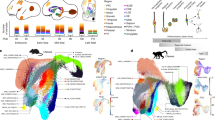Abstract
Maternal injection of 3H-thymidine ([3H]dT) during gestation in non-human primates (NHPs) has been used to determine the time of neurogenesis for various brain areas, including the lateral geniculate (LGN) and the pulvinar (PUL) nuclei of the caudal thalamus. Here, we examine neurogenesis in the rostral thalamus, with focus on the mediodorsal (MD) and the anterior nuclei (ANT), to determine if neurogenesis of rostral and caudal thalamic nuclei is concurrent or instead temporally staggered. The MacBrainResource (MBR) search function identified archived cases (N = 10) of [3H]dT labeled specimens, with injection dates ranging from embryonic day 25 (E25)–E50 and postnatal sacrifice dates. Slides were scanned to create digital images for subsequent analysis using Stereo Investigator software. Labeled neurons were mapped within a contour that encompassed the entire rostral thalamus. These maps were superimposed onto closely corresponding sections from the online BrainMaps macaque atlas to facilitate analysis. Our novel approach uncovered a previously undetected spatial–temporal patterning of neurogenesis in the thalamus. At E30, labeled neurons were located in a compact medial band; at E38–E40, labeling was dense ventrolaterally, and at E43, labeling predominated laterally at rostral levels and was widely distributed at caudal levels. Peak neurogenesis occurs earlier in MD (E30–E43) and ANT (E31–E43) than in LGN (E36–E43) and PUL (E36–E45). Birth-dating of neurons in MD and ANT, two higher order relay nuclei implicated in the pathology of schizophrenia, provides further insight into the critical period of vulnerability during which early developmental perturbation may increase incidence of schizophrenia later in life.





Similar content being viewed by others
Availability of data and materials
All slides used for analysis in this study are freely available to the public through MacBrainResource (macbrainresource.org), an online macaque brain resource that enables researchers to download digital, high-resolution images of slides.
Code availability
Not applicable.
References
Alexander GE, Crutcher MD (1990) Functional architecture of basal ganglia circuits: neural substrates of parallel processing. Trends Neurosci 13:266–271. https://doi.org/10.1016/0166-2236(90)90107-l
Altman J, Bayer SA (1979) Development of the diencephalon in the rat. IV. Quantitative study of the time of origin of neurons and the internuclear chronological gradients in the thalamus. J Comp Neurol 188:455–471. https://doi.org/10.1002/cne.901880308
Altman J, Bayer SA (1988) Development of the rat thalamus: II. Time and site of origin and settling pattern of neurons derived from the anterior lobule of the thalamic neuroepithelium. J Comp Neurol 275:378–405. https://doi.org/10.1002/cne.902750305
Altman J, Bayer SA (1989) Development of the rat thalamus: VI. The posterior lobule of the thalamic neuroepithelium and the time and site of origin and settling pattern of neurons of the lateral geniculate and lateral posterior nuclei. J Comp Neurol 284:581–601. https://doi.org/10.1002/cne.902840407
Angevine JB Jr (1970) Time of neuron origin in the diencephalon of the mouse. An autoradiographic study. J Comp Neurol 139:129–187. https://doi.org/10.1002/cne.901390202
Brand S, Rakic P (1979) Genesis of the primate neostriatum: [3H]thymidine autoradiographic analysis of the time of neuron origin in the rhesus monkey. Neuroscience 4:767–778. https://doi.org/10.1016/0306-4522(79)90005-8
Brand S, Rakic P (1980) Neurogenesis of the nucleus accumbens septi and neighboring septal nuclei in the rhesus monkey: a combined [3H]thymidine and electron microscopic study. Neuroscience 5:2125–2138. https://doi.org/10.1016/0306-4522(80)90128-1
Brown AS (2012) Epidemiologic studies of exposure to prenatal infection and risk of schizophrenia and autism. Dev Neurobiol 72:1272–1276. https://doi.org/10.1002/dneu.22024
Bubb EJ, Kinnavane L, Aggleton JP (2017) Hippocampal-diencephalic-cingulate networks for memory and emotion: an anatomical guide. Brain Neurosci Adv 1:2398212817723443. https://doi.org/10.1177/2398212817723443
Bystron I, Blakemore C, Rakic P (2008) Development of the human cerebral cortex: Boulder committee revisited. Nat Rev Neurosci 9:110–122. https://doi.org/10.1038/nrn2252
DeNicola AL, Park MY, Crowe DA, MacDonald AW 3rd, Chafee MV (2020) Differential roles of mediodorsal nucleus of the thalamus and prefrontal cortex in decision-making and state representation in a cognitive control task measuring deficits in schizophrenia. J Neurosci 40:1650–1667. https://doi.org/10.1523/JNEUROSCI.1703-19.2020
Driesen NR, Leung HC, Calhoun VD, Constable RT, Gueorguieva R, Hoffman R, Skudlarski P, Goldman-Rakic PS, Krystal JH (2008) Impairment of working memory maintenance and response in schizophrenia: functional magnetic resonance imaging evidence. Biol Psychiatry 64:1026–1034. https://doi.org/10.1016/j.biopsych.2008.07.029
Duque A, McCormick DA (2010) Circuit-based localization of ferret prefrontal cortex. Cereb Cortex 20:1020–1036. https://doi.org/10.1093/cercor/bhp164
Friedman HR, Selemon LD (2010) Fetal irradiation interferes with adult cognition in the nonhuman primate. Biol Psychiatry 68:108–111. https://doi.org/10.1016/j.biopsych.2010.02.021
Goldman-Rakic PS (1990) Cellular and circuit basis of working memory in prefrontal cortex of nonhuman primates. Prog Brain Res 85:325–336. https://doi.org/10.1016/s0079-6123(08)62688-6
Goldman-Rakic PS, Porrino LJ (1985) The primate mediodorsal (MD) nucleus and its projection to the frontal lobe. J Comp Neurol 242:535–560. https://doi.org/10.1002/cne.902420406
Gould BB, Rakic P (1981) The total number, time or origin and kinetics of proliferation of neurons comprising the deep cerebellar nuclei in the rhesus monkey. Exp Brain Res 44:195–206. https://doi.org/10.1007/BF00237341
Jankowski MM, Ronnqvist KC, Tsanov M, Vann SD, Wright NF, Erichsen JT, Aggleton JP, O’Mara SM (2013) The anterior thalamus provides a subcortical circuit supporting memory and spatial navigation. Front Syst Neurosci 7:45. https://doi.org/10.3389/fnsys.2013.00045
Kordower JH, Rakic P (1990) Neurogenesis of the magnocellular basal forebrain nuclei in the rhesus monkey. J Comp Neurol 291:637–653. https://doi.org/10.1002/cne.902910410
Kordower JH, Piecinski P, Rakic P (1992) Neurogenesis of the amygdaloid nuclear complex in the rhesus monkey. Brain Res Dev Brain Res 68:9–15. https://doi.org/10.1016/0165-3806(92)90242-o
Kril JJ, Harper CG (2012) Neuroanatomy and neuropathology associated with Korsakoff’s syndrome. Neuropsychol Rev 22:72–80. https://doi.org/10.1007/s11065-012-9195-0
McAllister JP, Das GD (1977) Neurogenesis in the epithalamus, dorsal thalamus and ventral thalamus of the rat: an autoradiographic and cytological study. J Comp Neurol 172:647–686. https://doi.org/10.1002/cne.901720407
McNaughton BL, Barnes CA, Gerrard JL, Gothard K, Jung MW, Knierim JJ, Kudrimoti H, Qin Y, Skaggs WE, Suster M, Weaver KL (1996) Deciphering the hippocampal polyglot: the hippocampus as a path integration system. J Exp Biol 199(Pt 1):173–185
Mikula S, Trotts I, Stone J, Jones EG (2007) Internet-enabled high-resolution brain mapping and virtual microscopy. Neuroimage 35:9–15
Mitchell AS (2015) The mediodorsal thalamus as a higher order thalamic relay nucleus important for learning and decision-making. Neurosci Biobehav Rev 54:76–88. https://doi.org/10.1016/j.neubiorev.2015.03.001
Ogren MP, Rakic P (1981) The prenatal development of the pulvinar in the monkey: 3H-thymidine autoradiographic and morphometric analyses. Anat Embryol (berl) 162:1–20. https://doi.org/10.1007/BF00318090
Pakkenberg B (1990) Pronounced reduction of total neuron number in mediodorsal thalamic nucleus and nucleus accumbens in schizophrenics. Arch Gen Psychiatry 47:1023–1028. https://doi.org/10.1001/archpsyc.1990.01810230039007
Papez JW (1937) A proposed mechanism of emotion. Arch NeurPsych 38:725–743. https://doi.org/10.1001/archneurpsyc.1937.02260220069003
Parnaudeau S, Bolkan SS, Kellendonk C (2018) The mediodorsal thalamus: An essential partner of the prefrontal ccrtex for cognition. Biol Psychiatry 83:648–656. https://doi.org/10.1016/j.biopsych.2017.11.008
Popken GJ, Bunney WE Jr, Potkin SG, Jones EG (2000) Subnucleus-specific loss of neurons in medial thalamus of schizophrenics. Proc Natl Acad Sci USA 97:9276–9280. https://doi.org/10.1073/pnas.150243397
Puelles L (2019) Survey of midbrain, diencephalon, and hypothalamus neuroanatomic terms whose prosomeric definition conflicts with columnar tradition. Front Neuroanat 13:20. https://doi.org/10.3389/fnana.2019.00020
Rakic P (1973) Kinetics of proliferation and latency between final cell division and onset of differentiation of cerebellar stellate and basket neurons. J Comp Neurol 147:523–546. https://doi.org/10.1002/cne.901470407
Rakic P (1974) Neurons in rhesus-monkey visual-cortex: systematic relation between time of origin and eventual disposition. Science 183:425–427. https://doi.org/10.1126/science.183.4123.425
Rakic P (1977a) Genesis of the dorsal lateral geniculate nucleus in the rhesus monkey: site and time of origin, kinetics of proliferation, routes of migration and pattern of distribution of neurons. J Comp Neurol 176:23–52. https://doi.org/10.1002/cne.901760103
Rakic P (1977b) Prenatal development of the visual system in rhesus monkey. Philos Trans R Soc Lond B Biol Sci 278:245–260. https://doi.org/10.1098/rstb.1977.0040
Rakic P, Nowakowski RS (1981) The time of origin of neurons in the hippocampal region of the rhesus monkey. J Comp Neurol 196:99–128. https://doi.org/10.1002/cne.901960109
Safari V, Nategh M, Dargahi L, Zibaii ME, Khodagholi F, Rafiei S, Khatami L, Motamedi F (2020) Individual subnuclei of the rat anterior thalamic nuclei differently affect spatial memory and passive avoidance tasks. Neuroscience 444:19–32. https://doi.org/10.1016/j.neuroscience.2020.07.046
Savage LM, Nunes PT, Gursky ZH, Milbocker KA, Klintsova AY (2020) Midline thalamic damage associated with alcohol-use disorders: disruption of distinct thalamocortical pathways and function. Neuropsychol Rev 31:447–471. https://doi.org/10.1007/s11065-020-09450-8
Selemon LD, Begovic A (2007) Stereologic analysis of the lateral geniculate nucleus of the thalamus in normal and schizophrenic subjects. Psychiatry Res 151:1–10. https://doi.org/10.1016/j.psychres.2006.11.003
Selemon LD, Friedman HR (2013) Motor stereotypies and cognitive perseveration in non- human primates exposed to early gestational irradiation. Neuroscience 248:213–224. https://doi.org/10.1016/j.neuroscience.2013.06.006
Selemon LD, Zecevic N (2015) Schizophrenia: a tale of two critical periods for prefrontal cortical development. Transl Psychiatry 5:e623. https://doi.org/10.1038/tp.2015.115
Selemon LD, Begovic A, Rakic P (2009) Selective reduction of neuron number and volume of the mediodorsal nucleus of the thalamus in macaques following irradiation at early gestational ages. J Comp Neurol 515:454–464. https://doi.org/10.1002/cne.22078
Sidman RL (1970) Autoradiographic methods and principles for study of the nervous system with thymidine-H3. In: Nauta WJH, Ebbesson SOE (eds) Contemporary research methods in neuroanatomy. Springer, Berlin, Heidelberg, pp 255–270
van Eerdenburg FJ, Rakic P (1994) Early neurogenesis in the anterior hypothalamus of the rhesus monkey. Brain Res Dev Brain Res 79:290–296. https://doi.org/10.1016/0165-3806(94)90134-1
Vertes RP, Linley SB, Hoover WB (2015) Limbic circuitry of the midline thalamus. Neurosci Biobehav Rev 54:89–107. https://doi.org/10.1016/j.neubiorev.2015.01.014
Wolff M, Alcaraz F, Marchand AR, Coutureau E (2015) Functional heterogeneity of the limbic thalamus: from hippocampal to cortical functions. Neurosci Biobehav Rev 54:120–130. https://doi.org/10.1016/j.neubiorev.2014.11.011
Young KA, Manaye KF, Liang C, Hicks PB, German DC (2000) Reduced number of mediodorsal and anterior thalamic neurons in schizophrenia. Biol Psychiatry 47:944–953. https://doi.org/10.1016/s0006-3223(00)00826-x
Acknowledgements
This work was supported by grant R01MH113257 (AD and LDS). We thank Mariamma Pappy for technical assistance.
Funding
This work was supported by Grant R01MH113257.
Author information
Authors and Affiliations
Contributions
All authors contributed to the study conception and design. Material preparation, data collection, and analysis were performed by Taylor Spadory. The first draft of the manuscript was written by Lynn Selemon and Taylor Spadory, and all authors commented on previous versions of the manuscript. All authors read and approved the final manuscript.
Corresponding author
Ethics declarations
Conflict of interest
The authors declare no conflicts of interest.
Ethics approval
Not applicable.
Consent to participate
Not applicable.
Consent for publication
Not applicable.
Additional information
Publisher's Note
Springer Nature remains neutral with regard to jurisdictional claims in published maps and institutional affiliations.
Rights and permissions
About this article
Cite this article
Spadory, T., Duque, A. & Selemon, L.D. Spatial–temporal topography in neurogenesis of the macaque thalamus. Brain Struct Funct 227, 1673–1682 (2022). https://doi.org/10.1007/s00429-022-02463-4
Received:
Accepted:
Published:
Issue Date:
DOI: https://doi.org/10.1007/s00429-022-02463-4




